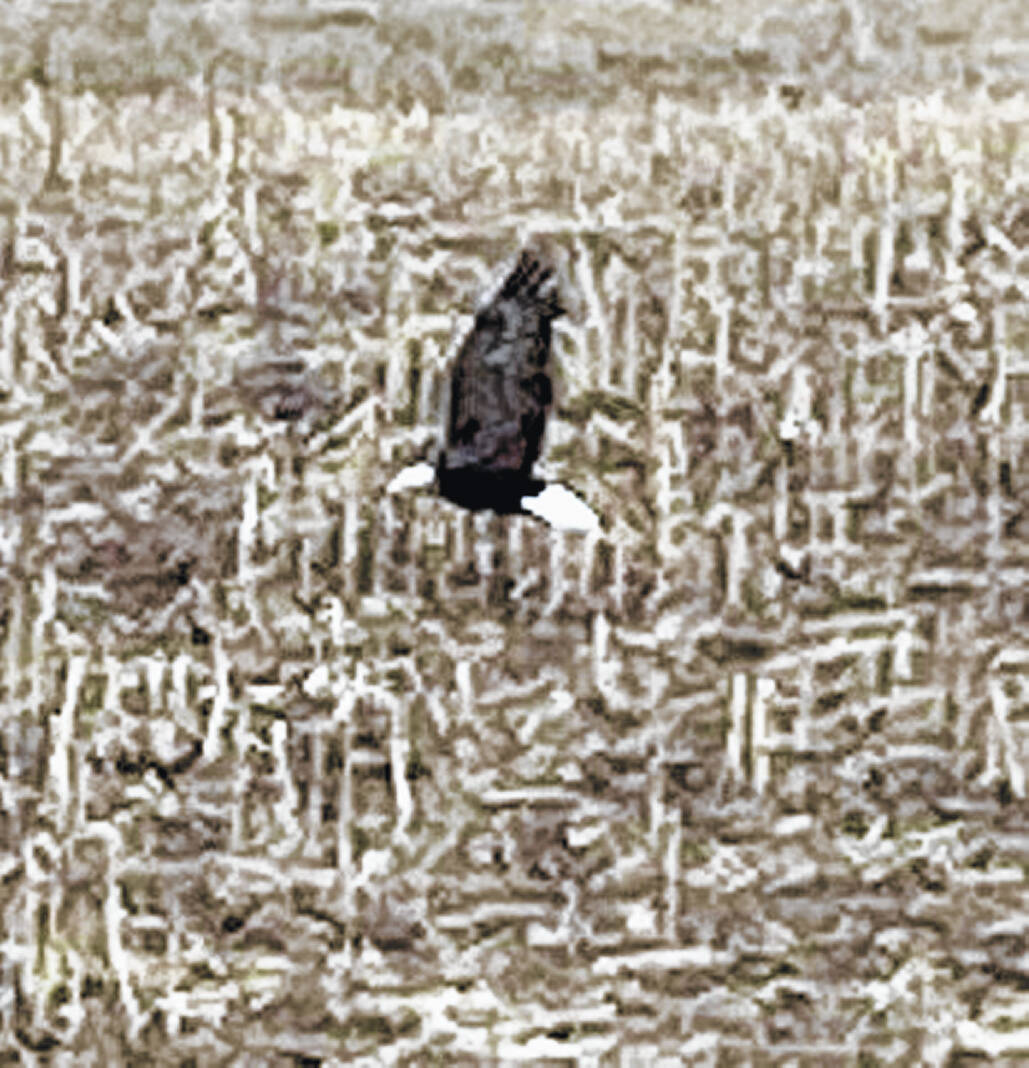
A bald eagle flies over a field last weekend along S.R. 28 near Greenfield.
Photo courtesy of Jim Edwards
During a trip with his father-in-law from Chillicothe to Greenfield last Saturday Jim Edwards was fortunate enough to spot a pair of bald eagles hunting along S.R. 28 near Greenfield.
“I saw them out there in the field, and they were kind of picking at a deer carcass out there,” said Edwards.
According to information provided by the Ohio Department of Natural Resources (ODNR), bald eagle nesting activity increases in the winter months, providing an excellent opportunity to watch the famed national birds hunt, improve nests and establish territory. Ohio’s bald eagles begin courtship and pair bonding in January, and that combined with an absence of vegetation makes this one of the best times to view them.
Ohio’s bald eagle population has increased dramatically in recent years, with an estimated 824 nesting pairs statewide in 2022. Eagles are typically found near their preferred aquatic habitats such as rivers, wetlands and frozen lakes, but they can occasionally be found sitting in open fields, according to the ODNR Division of Wildlife.
“The recent success of Ohio’s bald eagles is owed in a big way to improvements in the state’s water quality and habitat availability,” said ODNR Division of Wildlife Chief Kendra Wecker. “Expanding wildlife areas and Governor DeWine’s H2Ohio program to restore wetlands provides eagles with addition space to nest and raise their young. The bald eagle’s recovery is an example of how wildlife and habitats benefit when the state, conservation partners, and individuals work together.”
The bald eagle was once an endangered species with only four nesting pairs in Ohio in 1979. Partnerships between the ODNR, Ohio zoos, wildlife rehabilitation facilities, concerned landowners and conservationists helped to increase the population. The bald eagle was removed from the federal list of threatened and endangered species in 2007, and it was removed from Ohio’s list in 2012.
In the beginning of 2020, the ODNR worked to find every bald eagle nest in Ohio, and according to local natural resources officers several of the nests were found in Highland County.
At that time, a Rocky Fork Lake official said there was a nest on the southeast side of the lake, and that there was another nest along Paint Creek between the Highland/Ross County line and the village of Bainbridge. He also said he would bet money there were some nests along Rattlesnake Creek and one north of the Paint Creek reservoir.
Winter provides viewing opportunities for both adult and immature bald eagles. The white head and tail of the adult bird contrasts sharply with its dark body, a distinctive feature used to identify the species. An immature bird is more difficult to identify and has a mottled brown and white plumage for four or five years before attaining the recognizable field marks of an adult. A good pair of binoculars or even a spotting scope is recommended to spot birds at long distances.
Bald eagles in Ohio typically lay eggs and incubate in February and March, nesting in large trees such as sycamores, oaks and cottonwoods. Meanwhile, frozen lakes and rivers force the birds to expand their hunting grounds in search of fish and carrion, their foods of choice.
Lake Erie and other large bodies of water host the highest number of eagles because of easy access to food resources. Excellent viewing opportunities can be found at Magee Marsh Wildlife Area (Lucas and Ottawa counties), Pickerel Creek Wildlife Area (Sandusky County), Ottawa National Wildlife Refuge (Lucas and Ottawa counties), Mosquito Creek Wildlife Area (Trumbull County), and Killdeer Plains Wildlife Area (Wyandot and Marion counties). In southern Ohio, look near major rivers such as the Muskingum, Hocking, Scioto, and Great Miami, according to the ODNR.
As with many of Ohio’s native wildlife species, bald eagles require specific habitat conditions to thrive. Bald eagle habitat protection and research is funded by the sale of bald eagle conservation license plates, income tax check-off donations to the Endangered Species and Wildlife Diversity Fund, and sales of the Ohio Wildlife Legacy Stamp. Similarly, revenue derived from hunting and fishing license sales helps the Division of Wildlife expand wildlife areas and manage habitats for eagles and other wildlife.
All Ohioans can report active bald eagle nest sites at wildohio.gov or on the HuntFish OH mobile app. By reporting locations when you find a nest, you help biologists estimate eagle population dynamics and monitor trends, ensuring eagles continue to do well in Ohio.
Bald eagles are protected under both state law and the federal Bald and Golden Eagle Protection Act, making it illegal to disturb bald eagles. When viewing bald eagles, viewers should stay at least 100 yards away. Disturbing bald eagles at the nest site could lead the pair to abandon the eggs.
Reach John Hackley at 937-402-2571.

